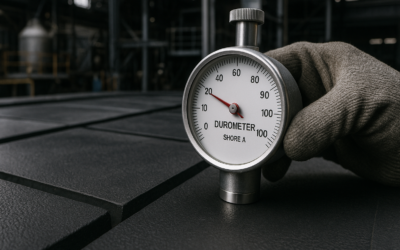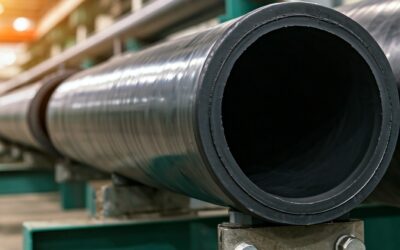Rubber linings protect industrial equipment against corrosion, abrasion, and chemical damage. They also protect storage tanks, pipes, or process vessels, extend equipment life, and keep operations running safely and smoothly.
But even the most durable rubber lining isn’t immune to failure. Lining materials can break down over time, or due to improper installation or exposure to harsh conditions. When they do, minor issues can quickly escalate into major problems like leaks, contamination, or unplanned downtime.
This blog will walk you through six of the most common rubber lining failure modes—what they look like, what causes them, and how to respond quickly to prevent costly damage and keep your business running.
6 Signs of Rubber Lining Failure to Keep an Eye Out For
From rubber cracking to chemical attacks, below are six of the most common signs of failure—and what to do if you spot them.
1. Rubber Cracking
What it looks like:
Cracks may appear on the surface of the rubber or run deeper into the lining, creating a brittle or flaky appearance. These are especially common in older linings or areas exposed to the elements.
Common causes:
Rubber cracking is often caused by prolonged exposure to UV rays, ozone, or high temperatures. It can also result from chemical incompatibility, oxidation, or simply aging rubber at the end of its service life.
How to respond:
Cracks are a clear warning that your lining is no longer providing full protection. At the first sign of cracking, remove the equipment from service and assess the extent of the damage. In most cases, a rubber lining professional should evaluate the material and recommend either spot repair or a full reline, depending on severity.
2. Debonding
What it looks like:
Debonding occurs when the rubber lining lifts or peels away from the substrate. You might notice visible gaps, curling edges, or bubbles forming beneath the surface. In severe cases, entire sections of the lining may detach.
Common causes:
Debonding typically stems from improper surface preparation during installation, moisture or contamination under the adhesive, or incorrect adhesive selection or application. It can also result from corrosion forming beneath the lining, compromising adhesion over time.
How to respond:
Debonding creates pathways for chemicals, moisture, and abrasion to reach the equipment surface, putting your system at risk. If you notice signs of separation, stop operation immediately and have the area inspected. A rubber lining expert can assess the substrate condition and reline the area using proper surface prep and bonding techniques to ensure long-term performance.
3. Blistering
What it looks like:
Raised, bubble-like formations under the rubber surface indicate blistering. These blisters are often soft to the touch and may contain air, liquid, or gas. In some cases, they can rupture and expose the substrate below.
Common causes:
Blistering usually results from trapped air or solvent during the lining installation process. Over time, permeation of process media—especially under pressure or heat—can also lead to blisters forming beneath the surface.
How to respond:
Blistering may indicate more than just a surface issue. In many cases, it signals hidden corrosion or delamination beneath the rubber. A lining professional should cut into the blister to evaluate its depth and determine if localized repair or complete removal and reapplication is required. Acting quickly helps prevent the problem from spreading and compromising more equipment.
4. Liner Erosion or Wear
What it looks like:
Signs of erosion include visible thinning, grooves, or worn patches in the rubber lining, especially in high-flow areas or zones exposed to abrasive materials. In severe cases, the substrate beneath the lining may become exposed.
Common causes:
Constant impact from slurries, solids, or abrasive particles can wear down high-performance linings. Other contributing factors include the use of rubber with insufficient hardness for the application or poor system design, which creates excessive turbulence or concentrated wear zones.
How to respond:
Erosion reduces the lining’s ability to protect your equipment and can quickly lead to leaks or structural damage. If you notice signs of wear, evaluate the rubber hardness and thickness in affected areas. Upgrading to a more abrasion-resistant formulation or redesigning the system to reduce wear (such as adding baffles or redirecting flow) can help extend the lining’s lifespan.
5. Chemical Attack
What it looks like:
If rubber appears swollen, softened, sticky, or cracked, it could indicate chemical attack. This is especially common in areas exposed to aggressive chemicals. Depending on the extent of chemical exposure, damage may be localized or spread across broader surfaces.
Common causes:
Chemical attack occurs when the rubber lining isn’t properly matched to the process media. Exposure to incompatible acids, solvents, or caustics (especially at elevated temperatures) can break down the rubber’s structure over time.
How to respond:
Stop the process at the first sign of chemical degradation and identify the chemical exposure. A lining expert can test the rubber and recommend a more chemically resistant formulation.
6. Undercure or Overcure
What it looks like:
Undercured rubber feels unusually soft, tacky, or weak, sometimes with a gummy texture. Overcured rubber, on the other hand, is tough, brittle, and prone to cracking. Both conditions compromise the lining’s protective properties.
Common causes:
Improper vulcanization during installation is the leading cause of this condition. Other causes include incorrect temperature or cure time, poor placement in the autoclave, or inconsistent heating across the lined surface.
How to respond:
Cut and test sample sections to determine the degree of cure. If undercure or overcure is confirmed, the lining may need to be reprocessed or replaced entirely. Working with experienced rubber lining professionals helps ensure proper cure cycles and consistent quality control, preventing premature failure.
Why Fast Action Matters
Rubber lining failures rarely fix themselves. Even minor issues can spiral into major problems if ignored. Cracks can deepen, blisters can rupture, and worn areas can quickly expose the substrate to corrosive or abrasive materials. The longer you wait, the greater the risk of equipment leaks, contamination, and unplanned shutdowns.
Catching signs of failure early and taking swift action can save thousands in repair costs and prevent costly downtime. Regular inspections and partnering with a trusted rubber lining provider are key to staying ahead of potential failures and extending the life of your equipment.
Don’t Wait—Get Expert Help with US Rubber
Not all rubber lining failures are easy to spot or fix. That’s why it pays to have a trusted partner who knows what to look for and how to respond.
At US Rubber, we bring decades of experience in diagnosing, repairing, and replacing rubber linings across a wide range of industrial applications. From on-site inspections and lab testing to full tank relining and preventative maintenance, we protect your equipment and productivity.
Is your lining failing? Contact US Rubber today to schedule an expert inspection or discuss your repair options.







